A LESSON IN LINE-SHOOTING
In April, Members, Ted Hackett and Svend Jensen, gave
your Editor a tour of the Edmonton Aircraft Meuseum. When we retired to
the coffee shop, I was introduced to a volunteer busy filling coffee filters
and getting ready for the coffee break crowd, a Mr. Cedric “Ced” Mah. To
make conversation, Ced asked me what types of aircraft I flew in. I said
that my first operational aircraft was the Blackburn Shark on pontoons,
out of Prince Rupert, B.C. Ced looked at me and said, “we used to watch
you take off and land in the harbour. We thought they were the biggest
aircraft.”
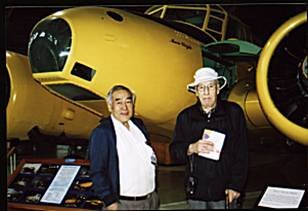
Cedric "Ced" Mah and your Editor
In front of Marie "Nipper" Wright's Anson
In those days Prince Rupert was a small town and I immediately
felt a bond between us. As I’m an incorigable line-shooter, I launched
into stories about the old Sharks. What I didn’t know, but learned
later, I was shooting a line to Cedric “Ced” Mah, US Air Medal, D.F.C.,
China National Aviation Corporation, who had completed 337 missions over
the Burma Hump, supplying aid to Chinese forces. Warning, before shooting
a line make sure you know at whom you are shooting.
We thank CNAC Web Director, Tom O. Moore Jr. http://www.cnac.org/webeditor01.htm
for granting us permission to publish a few highlights from Ced’s wartime
experiences gleaned from Web site http://www.geocities.com/cedmah/
.
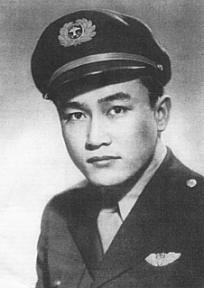
Cedric Mah US Air Medal, D.F.C
General Albert C. Wedemeyer, American chief of staff to
Chinese Nationalist leader Chiang Kai-shek, said, "flying the hump was
the foremost and by far the most dangerous, difficult and historic achievement
of the entire war." After the Burma road fell into enemy hands in the spring
of 1942, the China National Aviation Corporation (CNAC), formed by American
aircraft manufacturer Curtiss-Wright in association with the Chinese Government,
was charged with flying supplies over the Hump into occupied China. A tour
of duty officially comprised 80 such missions. Two Canadian brothers, Albert
and Cedric Mah, made 420 and 337 round trips respectively.
At age 17 Cedric Mah enrolled at the California Flyer’s
Aviation College and later took advanced instrument rating courses at Fort
Worth , Texas. In 1944 Ced left for Dinjan in India’s Assam Province to
join his brother, Captain Albert Mah who was already serving with CNAC.
Aircraft flown were the Dakota and Curtis C46.
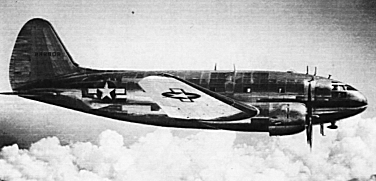
Curtis C46
When flying the Hump, sudden strong gusts could rip off
a wing or flip big aircraft on their backs. On one crossing Mah’s load
of lead ingots was bouncing up and down like corks in the ocean. The ingots
tore holes in the roof of the aircraft and then embedded themselves in
the floor. They hauled ammunition, petrol, gunpowder, and TNT, as well
as millions of dollars in Chinese currency, printed in the USA. On the
return trip out of China they carried cargoes such as mercury, tin, lead,
zinc, wolframite and hog bristles in their hard-worked aircraft.
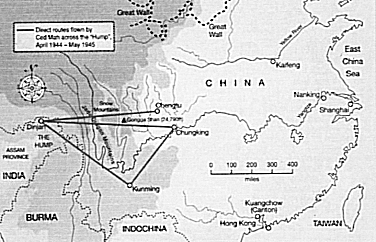
The Hump Route soon became known as the "graveyard of the
air." It was extremely dangerous flying in the high mountains, battling
variable weather conditions, cumulo-nimbus clouds, jet streams, and Japanese
fighters. At flight altitude pilots ran into 100–200 m.p.h. winds. If they
crashed in the jungles there were head hunters or enemy soldiers to finish
them off. The US Government offered highly prized bags of salt for every
downed airman returned alive to his base.
In August 1945 Cedric Mah’s most memorable adventure came
when he had to jettison $866 million in Chinese currency. The money, minted
in USA for the National Government, was destined for the Bank of China
in Chongjing, to replace worthless Japanese currency should VJ-Day arrive.
When he was transporting the money, his C-46 ran into trouble. Ice started
to build up on the wings and a hydraulic line sprung a leak, causing part
of the undercarriage to drop, creating considerable drag. Then one of the
two engines stopped.
As the aircraft plummeted from 22,000 to 12,000 ft. Mah
fought his way to the cargo hold and jettisoned 48 of the 52 bundles of
currency. Four bundles were held back in case they had to make a forced
landing, and if they survived, the money might buy their freedom.
At 10,000 feet Mah tried to restart the dead engine. It
popped, backfired, and miraculously started. The jettisoned money was never
found. Cedric wrote to his brother, “we traded $866 million for a $300,000
aircraft and our lives; a fair price.”
Eight months after Japan’s official surrender aboard the
Battleship
USS Missouri September 2, 1945, Ced took a short vacation
home, but returned to fly with CATC for the next three years supplying
the Nationalist troops, until China finally fell to the Communists.
On one occasion, Ced landed at an airstrip in Tuanuan
just as enemy shells fell within range. He left one engine running while
ground crews unloaded the aircraft, and dived for a dugout to avoid the
shrapnel. When the aircraft was ready for take off, he raced from the dugout
and jumped in. He started the aircraft down the runway while cutting in
the second engine.
Following the Communist take-over in China, Ced came home,
having logged 6000 flying hours, and became a bush pilot on the West Coast.
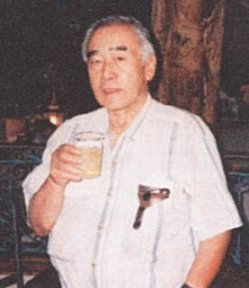 Official
recognition did not come for members of the American Volunteer Group, the
Flying Tigers, until 1991, and for the former CNAC pilots until 1995. In
1997 the US Government belatedly acknowledged the Mah brothers for their
service in China during the Second World War. They finally received an
honourable discharge, the US Air Medal, and the highest American air award,
the Distinguished Flying Cross. Earlier the Chinese Government had awarded
them the Hump Victory Medal.
Official
recognition did not come for members of the American Volunteer Group, the
Flying Tigers, until 1991, and for the former CNAC pilots until 1995. In
1997 the US Government belatedly acknowledged the Mah brothers for their
service in China during the Second World War. They finally received an
honourable discharge, the US Air Medal, and the highest American air award,
the Distinguished Flying Cross. Earlier the Chinese Government had awarded
them the Hump Victory Medal.
Ced Mah says, “for those who died flying the Hump, the
most dangerous air route in the world, we must pause and reflect. Their
bones lie white and shimmering in the vastness of the Trans-Himalayas.
We who winged beside you shall not forget.”
If you are ever at the Edmonton Air Museum be sure to
look up Ced. Also check out his web site at http://www.geocities.com/cedmah/
Just don’t shoot any lines, or ask him if he remembers
where he dropped the money.
D-Day Dakota KG395 continued
from May /07 Short Bursts Page
POST WAR
From Goose Bay the Dak was ferried to Ottawa, assigned
the Canadian Government call sign VCDHL, assigned to the RCAF, serial No.
12919. The Dak was used as an instrumental aircraft until being declared
surplus to the Canadian Air Force needs in 1970
Enter Don Brooks.
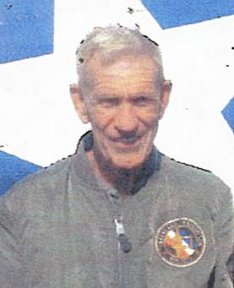 In
1973 Crown Assets Disposal Corporation sold the Dakota to Owen Wilson of
Calgary. The Dakota never received Canadian registration (Wilson obtained
the registration CZCR but it was not taken up) and was eventually sold
to Energy Incorporated of Corpus Cristi, Texas, in July 1985 after being
parked for some time in Themopolis, Wyoming. During July 1986, after being
Basler Flight Service purchased the aircraft and registered it N99FS. That
same year Basler sold the plane to Flight Service Incorporated of Panama
City, Florida. Current owner Don Brooks of Douglas, Georgia, purchased
the Dakota in March 1989.
In
1973 Crown Assets Disposal Corporation sold the Dakota to Owen Wilson of
Calgary. The Dakota never received Canadian registration (Wilson obtained
the registration CZCR but it was not taken up) and was eventually sold
to Energy Incorporated of Corpus Cristi, Texas, in July 1985 after being
parked for some time in Themopolis, Wyoming. During July 1986, after being
Basler Flight Service purchased the aircraft and registered it N99FS. That
same year Basler sold the plane to Flight Service Incorporated of Panama
City, Florida. Current owner Don Brooks of Douglas, Georgia, purchased
the Dakota in March 1989.
The Greenland Expedition
During 1942, Operation Bolero began as a massive build
up and movement of aircraft and supplies to Europe as the United States
entered the war. On 15 July 1942, six P38 Lightnings and two B17 Flying
Fortresses were flying the perilous Northern ferry route when bad weather
forced the fuel starved formation to crash land on the Greenland ice cap.
This route took aircraft to England via Canada, Greenland, and Iceland.
Ironically, this was the same route flown by KG395 in 1944 on her way to
war. Nearly 50 years later – in 1989, 1990, and 19922 – N99FS was utilized
by the Greenland Expeditionary Society to help recover one of the P 38s
from 268 ft. of ice, which had entombed the fighter since its crash landing.
Don obtained military surplus skis from an operator at
Yellow Knife, Northwest Territories, and fitted them to his Dakota for
landing on the snow and ice. The Dakota received a coat of highly visible
paint to help spotters find the aircraft if they had to put down.
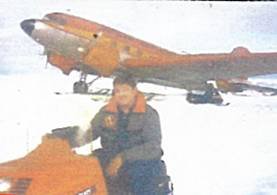
Don with his highly visible Gooney Bird in Greenland
The P38 was recovered and is flying in better than
new condition today.
Return to Normandy
In 1994 Don had his Dakota made ready for a return trip
to Normandy, France, for the 50th. Anniversary celebration of D-Day, which
included 26 Normandy Veterans jumping from KG395. The Gooney Bird’s high
visibility paint disappeared under a fresh coat of Olive Drab and Neutral
Grey camouflage. The Dakota was put back in its original markings it carried
during wartime, including the serial KG395 and D-Day invasion stripes.
A static jump line was installed to original specifications.
There was a delay at Gander Newfoundland due to a blown
engine however, with the help of Basler Flight Services, a replacement
engine was flown in and installed, and Dakota KG395 continued on to Glasgow,
Scotland.
On June 3rd. they were scheduled to fly to Caen, France
for a rehearsal flight over the drop zone at Sainte-Mere-Eglise. KG395
was once more back in its element as she crossed the English Channel and
headed over Utah Beach en route to Caen. A dry run was made over the drop
zone while US Army Rangers inspected the static line and got a feel for
the aeroplane
On June 4th. The ceiling was low and the winds were
gusting to 50 kns. The army had set a limit of 3400 ft. minimum. After
questionable weather the day before, fate smiled on the mission again and
June 5th. Dawned with calm winds and occasional cumulus clouds. The 27
Veteran D-Day jumpers met the crew at the Dakota, and their excitement
was evident as they were instantly transformed back into their younger
days. Once airborne with Pat Epps and Bob Harless at the controls, they
were obviously overcome with various emotions as the Dakota mumbling along,
brought back many memories.
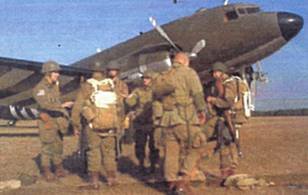
Veterans preparing for the jump.
After two passes over the drop zone, all the jumpers had
departed the Dakota , completing their historic mission once again. This
particular flight set a world record of age for one flight, totalling 1875.46
total years, averaging 72.13 years of age each! The mission was a huge
success and the whole world watched and read about it. Don had achieved
what he had set out to do, honour his father, who was a Gunner on a B-17
Flying Fortress, as well as all other Veterans who fought in WW II.
Today
Currently, the Dakota can be seen resting on the Ramp
at Douglas. She still sports her Olive Drab and D-Day stripes, although
the humid Georgia weather has somewhat taken its toll on the paint. Don
hopes to have the aircraft refinished in the near future. The static line
and jump seats are still installed, and the plane still frequents air shows
around the country. It is certainly a flying time capsule and is quite
popular with WW II re-enactors.
Don probably could not have picked a more historic Gooney
Bird to purchase, although he has also forged quite an interesting civilian
history with this aircraft.
The following web site contains excellent material on
DC 47 aircraft.
http://www.warbirdalley.com/c47.htm
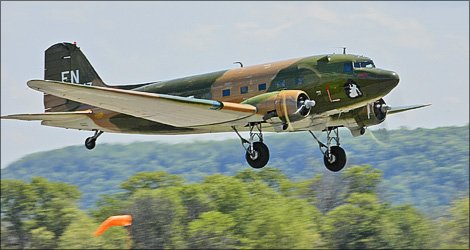
Dakota
Photo by Max Haynes - MaxAir2Air.com
"Probably the most memorable thing about the
[Dakota] was the smell. The odour of the leather mixed with hydraulic fluid
made a perfume second to none. [The plane] always treated me well, unlike
some of the other birds I've flown, and my memories of it are all good."
~ Tex Gehman, Winnipeg, Canada
Nicknames:
-
Gooney Bird; Super DC-3 (R4D-8);
-
Skytrooper;
-
Biscuit Bomber;
-
Tabby (NATO code name for the Showa L2D);
-
Cab (NATO code name for Lisunov Li-2);
-
Dumbo (SC-47 Search-and Rescue variant);
-
Sister Gabby/Bullshit Bomber (EC-47 dispensing propaganda-leaflets
in Vietnam);
-
Spooky/Puff the Magic Dragon (AC-47 Gunship);
-
Dowager Dutchess;
-
Old Methuselah;
-
The Placid Plodder;
-
Dizzy Three;
-
Old Bucket Seats;
-
Duck;
-
Dak;
-
Dakleton (South African C-47s which replaced their Avro Shackletons),
-
Vomit Comet (Nickname used by US Army paratroops during the
Normandy invasion.)
RETURN FIRE ON D-DAY DAKOTS KG395
ARTICLE
Dear Mr. Moyles,
Through Mr. Clarence Dixon I received a printed version
of "Short Bursts", the newsletter of the Ex Air Gunners. I noticed the
web address and just also visited your excellent airmuseum website.
Please allow me to introduce myself. My name is Arie-Jan
van Hees, 47 years 'old', amateur historian concentrating on the involvement
of the RAF in Operation "Market Garden", and Club Secretary of the RAF
Association, Amsterdam Branch / Club Limburg.
In 2000 I privately published my first book Tugs and
Gliders to Arnhem
(now sold out), followed in 2004 by Green On!
The Story of Arnhem Re-supply, September 1944. (400 pages / 600 photographs).
Out of a 1000 copies printed some 600 have now been sold of this book.
In addition to this, together with Mr. Alan Hartley (chairman
of the Down Ampney Association) and the Market Garden foundation, I am
one of the three-man team who took the initiative to have the Arnhem Aircrew
Memorial raised and unveilded in the grounds of the Airborne Museum Hartenstein
in Arnhem/Oosterbeek on 15 September 2006.
As Clarence mentioned on page 2 of your newsletter I supplied
him with the info on Dakota KG395. This article was again supplied to me
by one of the members of the Royal Netherlands Historical Flight who piloted
one of the Harvards while flying next to C-47 "Drag 'Em Oot" during the
15 September 2006 flypast over the Arnhem Aircrew Memorial. It's a small
world....
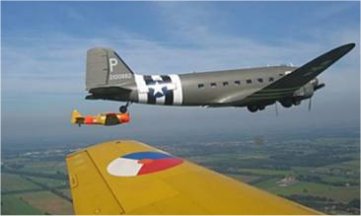
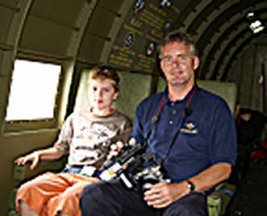
As a "Thank you" for all my actions over the past years
my son Jeroen of 9 years old, myself and my friend Frans Ammerlaan of the
Market Garden Foundation (have a look at their Digital Monument on www.marketgarden.com)
were given a flight in Mr. Paddy Green's C-47 "Drag 'Em Oot" (in WWII colours).
This took place on a historic date, 17 September (2006) while the Remembrance
Service was going on at the Airborne Cemetery in Oosterbeek, where so many
commonwealth aircrew are buried.
It was quite an experience to be in this historic aircraft
while it flew at treetop height giving a salute to all attendants of the
service, and of course, to our fallen heroes who died for our freedom.
I have attached a few photographs for you. Please feel
free to use them for your website or newsletter. If you would like to have
some more do let me know.
Please feel free to publish my name, address and website
to your readers.
I will only be too pleased to answer any questions with
regard to the involvement of the Royal Air Forces in Operation Market.
I would love to hear from veterans on their experiences. In the future,
when I will cease my research activities, my complete files will be deposited
at the Royal Netherlands Military History Institute. So readers of "Short
Bursts" please do not hesitate to send me your reader's questions or stories.
Information on my book "Green On!" can be found at http://www.rafarnhemresupply.nl
This website will be updated shortly, including material
on the Arnhem Aircrew Memorial and including a large article on the Arnhem
re-supply operations which will soon be published in a forthcoming issue
of Britain's top selling aviation monthly "FlyPast".
I trust to have been of service to you with the enclosed
information and look forward to hear from you.
Yours sincerely,
Arie-Jan van Hees
Club Secretary of the RAF Association, Amsterdam Branch
/ Club Limburg
Courtpendu 7
6245 PE
Eijsden
The Netherlands
Phone: 00-31-43-4092279
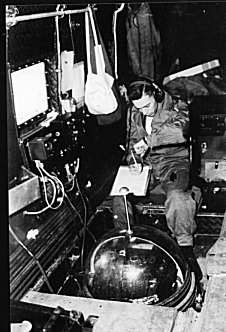 DAKOTAS
DAKOTAS
Dakotas were used in Canada, post war,
doing Profile Recording.
Here is one of our Members,
a young, handsome, camera operator,
Ted Hackett doing profile recording in Dak. KN277
borrowed from 412 Squadron, 1954.
Ted also flew in
Dakotas KG441, KG455, KG634.
At Cold Lake he flew in
10917, KK160, KG973, KN427, and 656.
Could any of our readers tell us
to what wartime squadrons these a/c belonged?
Ted is most likely saying,
“damn, it is way past my coffee break.”
Search Pattern
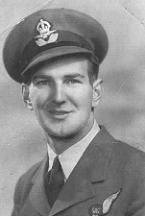 Does
anyone know this RCAF WAG?
Does
anyone know this RCAF WAG?
The only information we have is as follows.
His Christian name may be George.
He was from Ontario.
In 1945 he was stationed at RAF Melksham,
a wireless training school in the UK.
If you have any information on this gentleman,
please contact your Editor at:
John Moyles,
435 Froom Cres.
Regina, Sk.
S4N 1T5 CANADA
(306) 949-6112
Email moyles@accesscomm.ca
Dear Mr Moyles,
I am writing an article about an Australian airman, A.
Heymanson, who trained as a Wireless/Air gunner at Mossbank
-Saskatchwan, Canada as part of the British Commonwealth Air Training
Plan in 1943.
Could I please ask for your help. I am looking not for
the history of the gunnery school but the actual mechanics of the training.
Windage, fall of shot, deflection etc. In other words, how to shoot. Sgt
A. Heymanson eventually joined 195 Sqn as a top turret gunner in a Lancaster.
May I please ask if you can direct me to an internet site
or any other source where I might find the relevant information. Any assistance
you can give will be most appreciated.
Kindest regards,
Ken Wright.
wright9w@optusnet.com.au
Ed. I’ve wracked my brain – what little I have left
– and cannot recall a manual covering this at #2 B&G Mossbank, during
November 1941. All I can remember is trying not to throw up in the
Fairie Battle, and not to lose my hat to the slipstream while firing at
the drogue, as we didn’t have enough helmets to go around. Can anyone help
Ken?
Letter to our Web Master,
Bill Hillman.
Hi William:
I was very interested in the photo of the Blackburn Shark
in your Oct 2001 "Short Bursts" online newsletter. http://www.hillmanweb.com/rcaf/mag/exag0110.html
I believe that the pilot in the photo is my Uncle Gerald
McKenna. His flight log indicates that he flew Shark # 523 (indicated on
the tail of the aircraft) on Sept 26th and 27th, 1942 with F/S Hankinson
and F/S Moyles as shown in the photo. Gerald also flew with Sgt. Cousins
( the photographer is Tommy Cousins) on 3 flights in March 1942. I've attached
a scan of the relevant page of his flight log.
Gerald was killed in a crash in a Canso in Iceland on
Dec. 19th, 1944.
Do you have any more information about the photo?
Regards,
Stefan McKenna
stefan_mckenna@sympatico.ca
613.792.1636
56 Spadina Ave.,
Ottawa, Ontario
K1Y 2B6
Ed. Stefan Mckenna has just come into possession of
his Uncle’s log book. I have written Stefan and given him names and phone
numbers of WAGS who are mentioned in the log book as well as information
regarding 7BR Squadron during the time his uncle, Gerald McKenna, flew
with the Squadron. If any of our readers knew Gerald McKenna, Pilot, 7BR
and 162 Squadrons, give Stefan a call.
Another Odd Bomb Story
I enjoyed the "odd bombs" stories in your April issue
of Short Bursts. Here's another one, from Art Crighton of Edmonton....
Art Crighton, who marks his 90th birthday on D-Day, June
6, 2007, provided the following "odd bomb" story. Art was a Wellington
pilot during the war, shot down and spent over three years in Stalag Luft
III. There he put his musical background to work, teaching music and conducting
an airmen's orchestra. Following the war, he took a degree in music and
began teaching at the University of Alberta.
In the years following, he completed a master's degree
and then a doctorate in music, retiring as a professor at the U of A. I
first met Art in 1956 when I joined the U of A RCAF Squadron as a Flight
Cadet in the URTP program, having spent two years in high school as an
airman in aero engine mechanics with 418 City of Edmonton Reserve Squadron.
Art was an officer with university squadron, eventually reaching the rank
of Lt. Col. and was the last commanding officer when the squadron disbanded
in the 1960s.
I hadn't seen Art for some 43 years, until I was invited
to attend a regular monthly lunch meeting of an Edmonton group of RCAF
veterans who are former PoW's, escapees or evaders from the Second World
War. I was invited after my story of my uncle and all crew lost with RAF
101 Squadron appeared in the Edmonton Journal. That story is on the internet
at http://members.shaw.ca/johnchalmers/LM479/
Since then I have joined this great group of veterans
many times at their lunch meetings and have been pleased to be their guest
speaker on some occasions, talking about the RCAF and aviation research
I am doing. Over the past three and a half years, Art has become a good
friend, someone I know far better now than I did when I was a Flight Cadet
and he was an officer in my university squadron!
In the Spring 2007 issue of Airforce magazine, Art contributed
an article about his views of war and some of his prison camp experiences,
entitled "A Kriegie Remembers."
Here is his "odd bomb" story...
My "odd bomb" story is perhaps just an odd event. It developed
from my father's effort to ease my loneliness from home -- the Saturday
edition of the Calgary Herald. He was concerned about my journey to England
to join a squadron of ill-fated Wellington bombers threatening the Third
Reich. Hitler had turned his attention from the dismal Isle of Britain
to engage the forces of Russia. My duty as second pilot in a wavering Wimpy
was to distribute leaflets to the peasants below. This assumed management
of the bomber's flare chute. Not a challenging assignment after one has
learned to "extend the chute" so that leaflets will go down, not up to
plaster the walls of the Wimpy!
Duty accomplished on frequent occasions when I delivered
a western Canadian view of the war -- the latest Saturday edition of the
Calgary Herald -- generously supplied by my father. "Odd bombs away!"
Art Crighton lives at 8903 - 180 St. NW, Edmonton AB
T5T 0Y3
Cheers,
John Chalmers,
johnchalmers@shaw.ca
Edmonton
Our good contributor to Short Bursts, Ross Hamilton,
requested we insert a blurb asking for information on PRU Units, World
War II.
John, a favour from you.
In the current issue of "Airforce" Mag. there is an article
having to do with the PRU Sqdns. in the RCAF. The writer has been in touch,
and is being encouraged to proceed with a book he has started on this topic--
particularly as regards the RCAF- PRU's which, until now have been ignored.
I met up with some post-war, but have lost track.
Can you send out a "Mayday" to all & sundry who may
still have contact with any old PRU pilots.. (Spitfires & Mustangs)
We need Sqdn. numbers, contacts, e-mail addresses-- anything to help the
chap get this thing under way. He is the author of the "Airforce" article,
and has already done much initial work, but now needs some "First-hand"
input from those who were there. Many thanks.
Per Ardua.
Ross & Evelyn
Ed. Showing my ignorance, which is not hard, I asked
Ross the meaning of PRU. PMUs I understand .
Here is Ross’s caustic reply:
Hi John and Doreen. Thanks for yours of today. (Why didn’t
you ask Doreene? She knows what PRUs are!)
In the event, it is "Photo Reconnaissance Units".. the
guys flying Spitfires and Mustangs photographing the enemy positions
et al. Particularly prior to D-Day. While the RAF instituted their own
PR units, the RCAF also created one or two, but they were never recognized
for the great work they did.
The object here, John, is to try and locate some of these
pilots. As mentioned, the author of the article in "Airforce" is writing
a book about our RCAF guys primarily, and needs much input from any who
are still with us, simply what I had in my e-mail to you. A "Shot In The
Dark", but perhaps we can get the story told at long last. O.K.?
Personally, I knew two PRU pilots post-war... one S/L
Jack Watts DSO, whom I have long lost contact with, and a second chap who
was with my firm, one F/L Ralph Ritchie who, sadly, passed away at age
59. A good friend of many years. He flew Spitfire MK-X1Vs and Mustangs
with one of the Squadrons -- 414, RCAF.
As mentioned, the detail in my (first) e-mail is
about all that is needed. (Doreen will know!) Per Ardua, Ross &
Evelyn
If any reader can throw light on the history of RCAF
PRU units, give Ross a shout. evelynrosshamilton@telus.net
Book Review
Voices of THE DONEGAL CORRIDOR
By Joe O’Loughlin
Nonsuch Publishing Limited
73 Lower Leeson Street
Dublin 2, Ireland.
www.nonsuch-publishing.com
ISBN 1 84588 526 0
9” x 6 ½” Soft cover 94 pgs.
52 pictures. Price 11.49 pounds
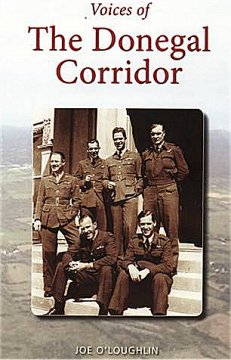 At
the outbreak of WW II the British asked Eamond DeValera to grant them permission
to use the West Coast ports of the Irish Free State. He refused, as he
did not want to violate their neutrality. However, DeValera did agree to
Allied aircraft flying over a narrow strip of County Donegal, to give the
Coastal Command Squadrons direct Westerly access to the Atlantic convoy
routes.
At
the outbreak of WW II the British asked Eamond DeValera to grant them permission
to use the West Coast ports of the Irish Free State. He refused, as he
did not want to violate their neutrality. However, DeValera did agree to
Allied aircraft flying over a narrow strip of County Donegal, to give the
Coastal Command Squadrons direct Westerly access to the Atlantic convoy
routes.
This flyway became known as The Donegal Corridor. DeValera
also approved of an RAF rescue launch to operate off the West Coast of
the Corridor, on the understanding that the craft should be fitted out
like a fishing vessel and the crew should wear civilian clothing.
Joe O’Louglin was only a boy during the war but, living
in County Fermanagh, he watched the air traffic of Coastal Command Squadrons
stationed in Northern Ireland as they flew the Donegal Corridor, and witnessed
some of the crashes.
Joe has put together a documentary that gives the reader
information and circumstances regarding aircrew who were killed in Northern
Ireland, and memorial cairns he helped sponsor on crash sites. But the
main theme of this work is the locating of relatives and loved ones of
those lost so many years ago, so meaningful ceremonies could be conducted.
In many cases the families had only received an official telegram from
the War Ministry, or a letter from a Squadron Commander or Padre, but they
were never told the circumstances surrounding the death of their loved
ones.
The following is only one example of how the author brought
the complete story and closure to one family.
Norman Muffitt, who has been a contributor to Short Bursts,
was only one year and five months old when his father, Ted Muffitt, Captain
of Catalina FP130, was killed when their aircraft failed to return from
a mission off the West Coast of Donegal, in November 1943. Only the telegram
of regret was received.
Sixty years later, through much research, and confirmed
by another crew, it was determined that, when Captain Muffitt released
the depth charges 50’ above the target, they exploded on contact with the
water destroying aircraft and crew. Depth charges were supposed to sink
20 feet into the water before detonating, however, due to faulty (or improperly
set) detonators, the charges exploded prematurely on contact.
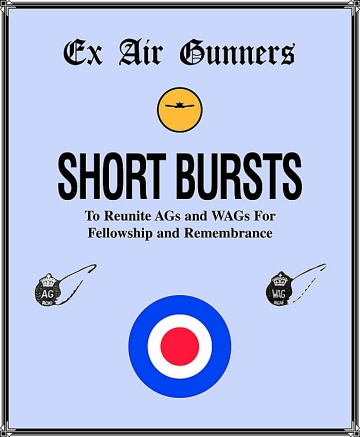

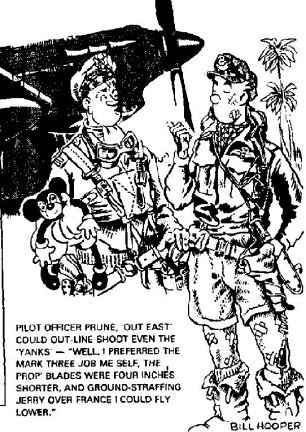
![]()
![]()
![]()